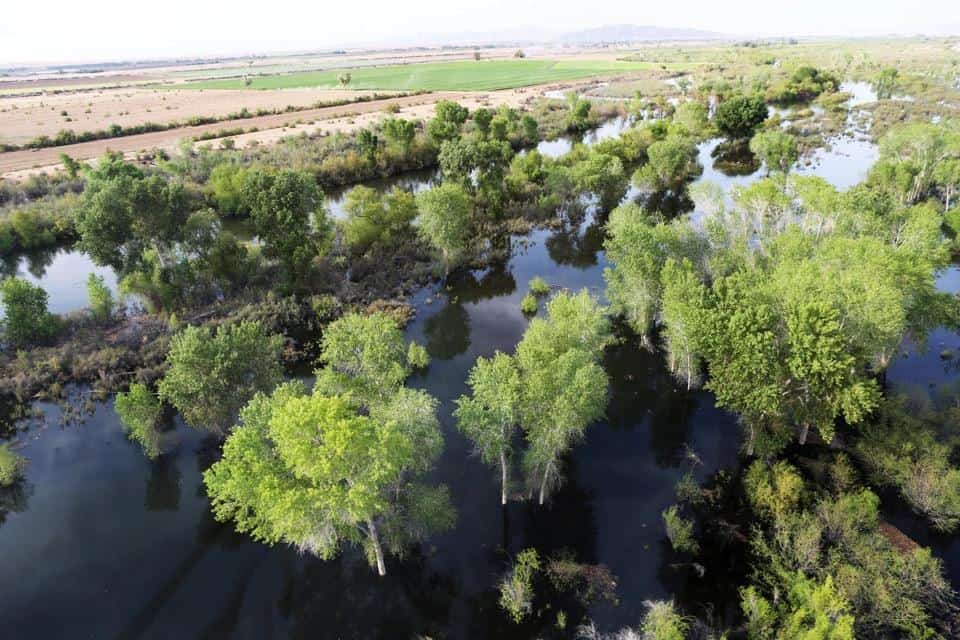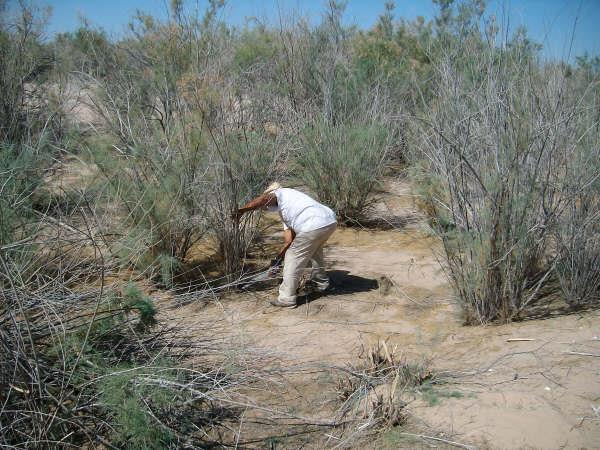
The pulse flow from Minute 319 returned water to dry riverbeds (photo courtesy of Pronatura Noroeste).
By SJV staff in collaboration with Osvel Hinojosa-Huerta, Director of Pronatura Noroeste’s Northwest Water Conservation Program
The Colorado River Delta is one of the most important wetlands in the Sonoran Desert. The nearly 250,000 acres of natural areas in the delta include riparian woodlands, an extensive floodplain, brackish marshes, and large estuarine areas. The delta provides habitat to over 360 species of migratory and resident birds.

The pulse flow from Minute 319 flooded riparian zones, sustaining native Cottonwood and Willows (photo courtesy of Pronatura Noroeste).
Diminishing water availability, mainly due to habitat loss and modification, brought water policy to the forefront in 1944 when the U.S. and Mexico signed a treaty to govern how water was to be managed across the shared border. The last major treaty update, Minute 319, was signed in 2012. That historic and monumental binational agreement involved water allotments to Mexico under surplus and shortage conditions, gave Mexico flexibility to store water in Lake Mead, and identified water conservation projects and restoration opportunities. One of the most visible outcomes of Minute 319 was a pulse flow from the Colorado River during the spring of 2014, which delivered 130 million cubic meters, followed by an additional 65 million cubic meters as a base flows at the end of the summer of 2014. The pulse flow allowed the Colorado River to reach the delta for the first time in many years.
This year marks another important milestone for the continued collaboration between SJV partners in the U.S. and Mexico, including Pronatura Noroeste, The Sonoran Institute, The Nature Conservancy, and Audubon Arizona.
On September 27 policy makers, water agencies, and conservation organizations from the U.S. and Mexico witnessed the signing of Minute 323, the most recent addendum to the 1944 Water Treaty. The new U.S.-Mexico Colorado River agreement sets aside 210,000 acre-feet of river water for environmental restoration in the delta, starting in 2018. The goal is to restore about 4,300 acres over the next nine years.

Volunteers work to remove invasive Salt Cedar in preparation for planting native vegetation (photo courtesy of Pronatura Noroeste).
Dr. Osvel Hinojosa-Huerta is the director of the Pronatura Noroeste’s Northwest Water Conservation Program. He has been studying the ecosystem of the CO River Delta for over 20 years. The program covers 50 wetlands and ten priority basins in northwestern Mexico. It focuses on the conservation and restorations of key sites, the protection of fresh water flows, and the harvest of water by reforestation. In order to inform conservation planning, Pronatura Noroeste created a long-term coordinated bird monitoring program across the Colorado River basin. The team surveys hundreds of points along the riparian corridor, including sites such as Ciénega Santa Clara in Sonora and along the Hardy River in Baja California.
In addition to studying the changes in abundance, diversity, and composition of the riparian and marshbird bird communities, Pronatura also studies the floodplain of the Colorado River, including the relationship of birds to surface and groundwater changes, vegetative communities, as well as the effects of the restoration activities. Despite having lost roughly 80% of historical wetlands in the Colorado River basin, about 100,000 acres remain. Results from Pronatura’s studies have found that these areas are still critically important, providing habitat for riparian breeding birds, marshbirds such as Yuma Ridgway’s Rail (Rallus obsoletus yumanensis), as well as stopover habitat for many waterbirds and neotropical migrants. By surveying before, during, and after restoration efforts, Pronatura biologists have the opportunity to monitor the transitions to find out which techniques are most effective, guiding conservation planning. They have found that the abundance of birds in restored areas increases on average 28% and diversity increases by about 53%, demonstrating improvements to ecosystem health following restoration activity.
Working in collaboration with governmental agencies on both sides of the border, binational non-profit organizations, and the local communities, habitat restoration efforts that remove invasive species and replant with native species, in addition to the water flows enacted by Minute 319, have shown incredible results. Dr. Hinojosa-Huerta estimates that the first round of flows has restored about 1,800 acres of cottonwood, willow, and mesquite habitat. In that time, conservation groups, led by Raise the River, planted more than 230,000 native cottonwoods and willows along the river. The effort has also secured about 8,200 acre-feet of new water rights to use towards habitat restoration and protected an additional 37,000 acres of marsh habitat.
Dr. Hinojosa-Huerta says that the main thing they have learned is that the ecosystem is actually very resilient, and he is optimistic about the new Minute 323 agreement. The scientific analyses that were done during the first round of pulse and base flows better equips partners to prepare new restoration sites and mimic natural pulses to maintain active restoration sites. In addition to positive effects of the restoration on ecosystem health and wildlife, there has also been a profound social response. The staggered release of water in 2014 brought not only scientists, but also local residents to marvel at the site of water returning to dry riverbeds and play in the river. It was the first time in 30 years that the Colorado River connected with the Gulf of California. For many residents, it was the first time in their lives that they had seen water flowing. This created a new sense of wonder and connection with the land, all which goes a long way towards gaining support for conservation efforts. Through a regional, science-based approach to water conservation, combined with successful binational cooperation, the new U.S.-Mexico Colorado River agreement will see the continued resurgence of the Colorado River Delta.


 English
English  Español
Español 
